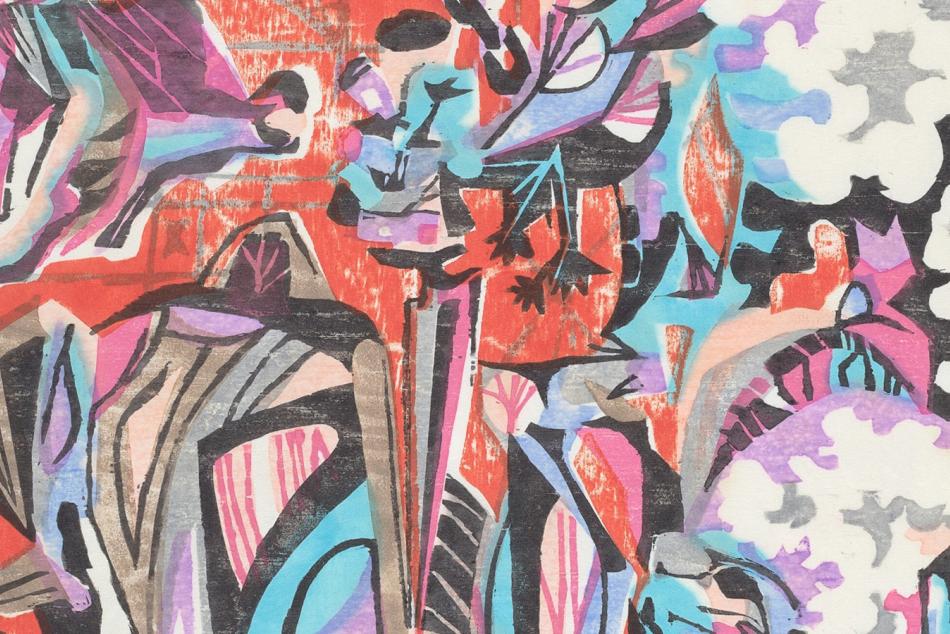The Diner on the Edge of Civilization: Richard Misrach’s Photograph of Outdoor Dining

Food is a basic human need. In our Food for Thought series, James Beard Award–winning journalist, scholar, and writer Cynthia Greenlee hosts a gathering of historians, food journalists, poets, chefs, and farmers and invites them to riff on food-related works of art in our permanent collection.
It’s hard to tell where the light is. The sky is grey-white, like the salt below. Once, this was an inland sea, a span of blue that commanded 20,000 square miles and, at its deepest, plunged a thousand feet. Was there anyone to see it? Our ancestors—those who crossed the tundra from what is today eastern Siberia to this continent, before the glaciers melted and the way back was lost—did they arrive in time? The sea’s retreat started in 15,000 BCE. It left rings in the hills. The water took to the air; the salt remained.
Every summer, after the winter rains replenished the salt, car racers used to make a pilgrimage here to hurtle across the blankness, testing, teasing, worrying at the borders of the possible. The fastest ever on the flats was the Blue Flame, a car almost all nose. It was 38 feet long and narrowed to a point like a rocket, fueled by hydrogen peroxide and liquefied natural gas.
In 1970, 22 years before this photograph was taken, the Blue Flame clocked 622.407 miles per hour—one mile in less than six seconds. But decades of mining for potassium and magnesium have weakened the salt crust and left it thin and fragile. Those who seek true speed, who want to write their names on eternity, must now go elsewhere.

A Diner in the Salt Desert
In Richard Misrach’s photograph, nothing stirs. The salt does not permit life. No rustle of an insect’s wings, no tentative green stem, no roots weaving a web below. In its bareness, it calls to mind the open space in Jorie Graham’s 1987 poem “What the End Is For”: “this meadow we lie on our bellies in, this field Iconography / tells me stands for sadness / because the wind can move through it uninterrupted.”
But here: an interruption. Your table is ready. Soon there will be the scrape of chairs and salt crunching underfoot. Food that could never be grown in such soil will appear, and more salt will be sprinkled on it. Traffic cones mark a vague border, perhaps in hopes of corralling customers so they don’t stumble out into the white, mesmerized, never to return.
Surely the photograph is staged, but no. An old-school diner has materialized in the desert, as if deposited by a passing tornado, without walls and naked to the elements, outside time. The menu is unseen, but surely it would not surprise: biscuits and gravy, chicken fried steak, a short stack with an even ratio of syrup to pancake; heavy, anchoring foods, a promise of plenty amid desolation.
This is explicitly a tourist spot, a vantage point from which to take your own snapshot: one that tries to impose a frame on the enormous landscape—to take nature at its most excessive and free and make it fit for consumption.
Humans Consume the Natural World
To the greedy human gaze, what are the salt flats but a backdrop, a vista that exists only for our awe and pleasure. What is emptiness but something to be claimed? In Empty Meeting Grounds: The Tourist Papers, the anthropologist Dean MacCannell writes, “Tourism has managed (and this is its special genius in the family of human institutions) to put a value on propertylessness itself.”
Still, how small the traffic cones are: timid orange peaks, with the giants of the mountains in the distance. The curves of the Coca-Cola logo sneak over the edge of the bar, swoopy and reassuring. But they’re a relic, a memory of the once-standard Spencerian script designed by an Ohio calligrapher in 1848 to mimic waves and natural forms. That script has now long fallen out of use.
Misrach shows us how human values—the supremacy of industry and capital, the gnawing need to forever consume—encroach on the natural world, corrupting it.
Outlasting Civilization
But who is the victor here? As MacCannell writes of Yosemite: “It is so beautiful that it just might be immune to the ravages of civilization. It challenges the worst in us, the part which wants to compete with nature and eventually to win.” The same is true of Bonneville in Misrach’s photograph.
The scene is uninhabited, as if the meal has ended and everyone has washed up and returned indoors to the safety of proper plush beds. Or maybe there is no meal, will never be a meal, like in those eerie fake towns that the military built in the desert in the 1950s to test the impact of nuclear bombs.
Maybe this time it’s real and the apocalypse has caught us in our tracks, vaporized us. And all that’s left are these immaculate tables waiting for diners who will never come. Meanwhile, the salt flats and the mountains stay or fritter away or rebuild themselves, according to their own deeper tide of time, while the world continues.
You may also like

Article: Eldzier Cortor Takes Us Inside the Slaughterhouse
Through his surrealist woodcut, Cortor considers the relationship between humans and animals and tells the stories of Black bodies.

Article: Dr. Martin Luther King Jr.’s Table: Breaking Bread in Troubled Times
A deeper look at how photography became a tool for the Civil Rights leader.


